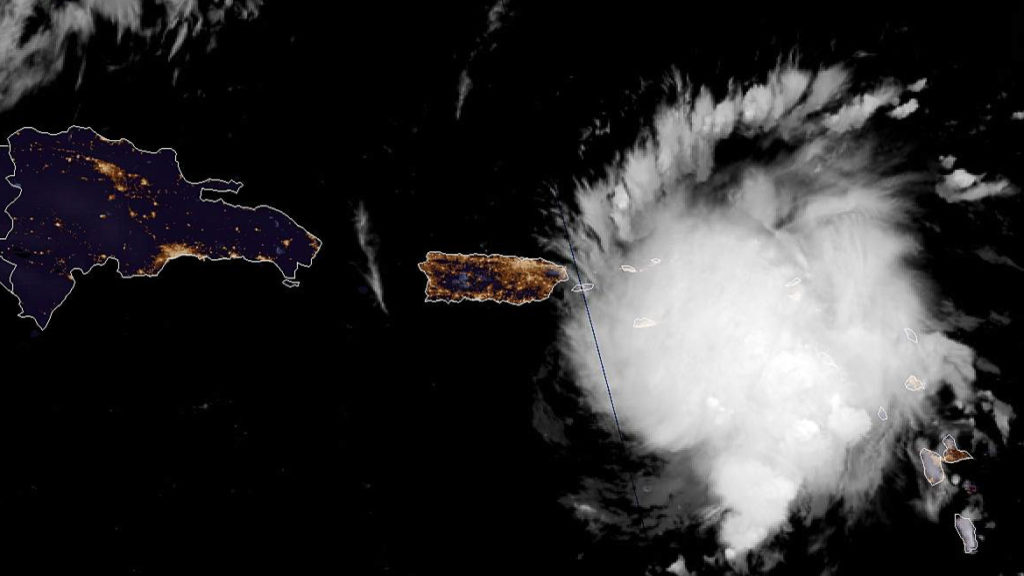Puerto Rico Braces for Dorian, System Forecast to be Hurricane
August 28, 2019

In this enhanced satellite image with graphics from NOAA, street lights can be seen from space as Tropical Storm Dorian approaches Puerto Rico, early morning Wed, Aug. 28,2019. Officials on the island are worried about a power grid that remains shaky after Hurricane Maria in 2017. (NOAA via Key News)
The National Hurricane Center says nearly all the intensity models show Tropical Storm Dorian becoming a hurricane after hitting Puerto Rico and then getting stronger while threatening the Bahamas and the southeastern United States.
Key Biscayne remained in monitoring mode, with the storm expected to near the Florida Coast over the weekend. Village officials continue to track the storm and focus on preparedness, again urging residents to double-check their evacuation plans. Officials urged residents to prepare and not focus on the storm path.
“Two out of three times, it’s in the cone. One time out of three, it’s not. People in South Florida need to prepare,” said Dennis Feltgen, a spokesman for the Hurricane Center.
Dorian’s exact path remains very difficult to predict, but forecasters say nearly all their models suggest residents of Florida should keep close watch as the storm approaches the U.S. coast this weekend.
“There has been considerable run-to-run variability among the models so confidence in the long term track remains low,” wrote Hurricane Specialist John Cangiolosi.
At 8 a.m., Eastern Time, Dorian had winds of 60 miles-per-hour (95 kph) and was 60 miles (95 km) southeast of St. Croix, heading northwest at 13 miles-per-hour (20 kph)

In this graphic from the National Hurricane Center, the forecast track for Dorian is shown as of 5 a.m., Aug. 28th. (National Hurricane Center via Key News)
In Puerto Rico, residents braced for storm conditions where landslides, widespread flooding and power outages possible. President Donald Trump declared an emergency Tuesday night and ordered federal assistance for local authorities.
“Practically the entire island will be under sustained tropical storm force winds,” said Roberto García, director of U.S. National Weather Service San Juan, during a press conference late Tuesday.
Early Wednesday, Dorian was located about 240 miles (390 kilometers) east southeast of Ponce, Puerto Rico, and the storm is expected to dump 4 to 6 inches (10 to 15 centimeters) of rain with isolated amounts of 8 inches (20 centimeters).
The change in the storm’s course concerned many across the U.S. territory, where some 30,000 homes still have blue tarps as roofs nearly two years after Hurricane Maria. The island’s 3.2 million inhabitants still depend on a shaky power grid that has remained prone to outages since it was destroyed by the Category 4 storm.
Jorge Ortiz, a 50-year-old construction worker, was taking no chances. Wiping sweat from his brow, Ortiz climbed up a shaky ladder under a punishing morning sun and tied down pieces of zinc that now serve as his roof because Maria ripped the second floor off his house when it hit on Sept. 20, 2017.
He was forced to rebuild everything himself and finished just three months ago with no assistance from the local or federal government.
“They told me I didn’t qualify because it was a total loss,” he said, shaking his head as he added that he was wary. “I’m worried that despite all this sacrifice, I’ll lose it again.”
The U.S. National Hurricane Center issued a hurricane watch for Puerto Rico and a tropical storm warning for Puerto Rico, Vieques, Culebra and the U.S. Virgin Islands. A tropical storm watch was in force for the Dominican Republic from Samaná to Puerto Plata.
Although top government officials in Puerto Rico said they were prepared for the storm and had sufficient equipment, a couple of mayors, including those in the western region, said they did not have enough generators or shelters that were properly set up.
Jesús Laracuente, a 52-year-old construction worker who lives in the impoverished neighborhood of Las Monjas in the capital of San Juan, also had doubts about government preparations.
“The people here are prepared. We already learned our lesson,” he said, referring to Maria. “What despairs us is knowing that the slightest breeze will leave us without power. It’s the government that fails us.”
José Ortiz, executive director of Puerto Rico’s Electric Power Authority, acknowledged that the distribution system still has weak areas and could “suffer” under winds of 50 to 60 mph. However, he stressed the agency has the needed inventory, including more than 120,000 lights, 23,000 poles and 7,400 transformers.
But Freddyson Martínez, vice president of a power workers’ union, told The Associated Press that while the electric grid has improved in some areas, he worries about a lack of power line workers and post-Maria patches which feature lines affixed to palm trees.
“Those are problems that are still being corrected to this day,” he said. “These are the realities we have to face with this storm.”
Puerto Rico Gov. Wanda Vázquez urged those living in flood-prone areas or under a blue tarp to move into one of the island’s 360 shelters on Tuesday night. Housing Secretary Fernando Gil has said some 9,000 to 13,000 homes with blue tarp roofs are located in the region that Dorian is expected to affect the most.
Officials also said public schools and government offices would remain closed through at least Thursday.
“We learned our lesson quite well after Maria,” Vázquez said. “We are going to be much better prepared.”
Dorian was expected to move near the Turks and Caicos Islands and southeastern Bahamas on Thursday night or Friday.
Meanwhile, Tropical Storm Erin formed well off the U.S. East Coast on Tuesday night, and the National Hurricane Service said the storm is forecast to move northward over the open Atlantic with no threat to land.
It was about 690 miles (1,110 kilometers) west of Bermuda and 300 miles (482 kilometers) southeast of Cape Hatteras, North Carolina, with maximum sustained winds of 40 mph.
Key News’ Tony Winton contributed to this report.


